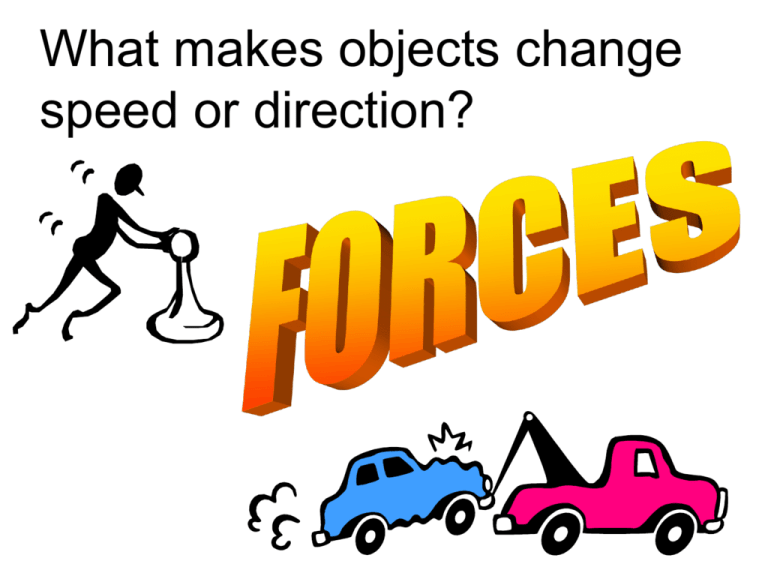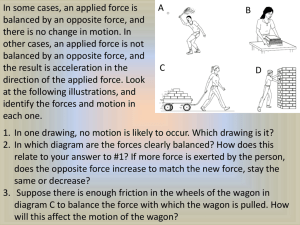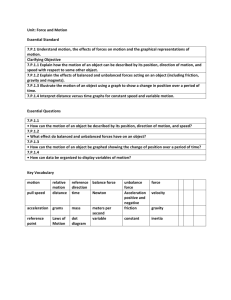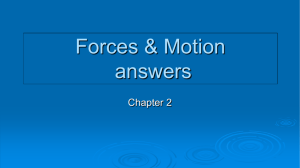Balanced Force - Mr. Kemp's Physical Science Class
advertisement

What makes objects change speed or direction? What is a Force? Definition: A force is a push or pull that causes an object to move, stop, or change direction In physics, a force is anything that makes an object accelerate What is a Force? • The student is pushing down on the chair, but the chair does not move. • The floor is balancing the force by pushing on the chair. What is a Force? • In science, a force is a push or a pull. • All forces have two properties: –Direction and Size • A newton (N) is the unit that describes the size of a force. Newtons? Sir Isaac Newton? Yes! The unit for measuring force is NEWTON(S). It is named for that famous scientist! Forces in the Same Direction • When forces are applied in the same direction, they are added to determine the size of the net force. Forces in Different Directions • When two forces act in opposite directions, you subtract the smaller force from the larger force to determine the net force. • The net force will be in the same direction as the larger force. Balanced & Unbalanced Forces Balanced Force • When the forces on an object produce a net force of 0 N, the forces are balanced. • There is no change in the motion of the object. Balanced Forces They are equal in size and opposite in direction Balanced Forces (Balanced Forces = No Acceleration) 5N Object Notice that all the forces are equally pointed in the opposite direction. Hence they balance each other – or cancel each other. 5N Equal Pushing Forces may cancel each other and produce No Acceleration! Balanced Forces 10N 10N 10N Balanced Push i.e. Pushing a Car No Acceleration 10N Balanced Pull i.e. Tug-o-war No Acceleration Balanced Forces (Balanced Forces = No Acceleration) Ground pushes up Gravity pulls down Gravity pulls down on you… The ground pushes back up… THIS KEEPS YOU WHERE YOU ARE! If these football players push on each other equally as hard, will either one move? Unbalanced Force • When the net force on an object is not 0 N, the forces on the object are unbalanced. • Unbalanced forces produce a change in motion of an object. Unbalanced Forces Causes Acceleration Adding Forces 5N Object 5N Notice that all the forces are pointed in the same direction. Hence they add together. Unbalanced Forces Causes Acceleration Subtracting Forces 5N Object 5N Notice that all the forces are unequal and pointed in the opposite direction. Hence they are unbalanced and in opposition to each other – or one partially cancels the other. 5N Unbalanced Forces Causes Acceleration Adding Forces Subtracting Forces Un-Balanced Forces Additive 10N 10N Un-Balanced Same Direction Faster Acceleration Un-Balanced Opposite Direction Slower Acceleration Subtractive 10N 10N 10N Subtracting Forces 10 N =5N 5N • Two forces can subtract to produce a net force in the direction of the larger force. – Negative Acceleration occurs (Slow Down) Balanced v. Unbalanced Forces • If all forces are balanced there is no acceleration in any direction. – (Either Zero Motion or Constant Velocity) • If one force is greater than the opposing force we get acceleration in a direction. Are these Balanced or Unbalanced Forces? Force – Examples: Balanced Force Examples: Unbalanced Force Examples: Net Force – Example: Newton (N) – Examples: 4 N, left – 10 N, right = 6N, right Force – A push or pull on an object Examples: pushing a shopping cart or pulling a wagon Balanced Force – Equal forces acting on an object in opposite directions. (Object is still) Examples: Unbalanced Force – Unequal forces acting on an object which causes it to move Examples: Net Force – a combination of the magnitude (difference between 2 forces) and direction (direction of largest force) Example: 4 N, left – 10 N, right = 6N, right Newton (N) – The metric unit of measuring force Examples: Balance between Gravity and Friction Q: If the friction of the air and the pull of gravity were in perfect balance, what would the skydiver be doing? A: The skydiver would be going a constant velocity (moving with no acceleration) down towards the ground until it hit the ground. The skydiver is colliding with the molecules of gas in the air! Which slows down the fall of the skydiver! Accelerating Constant Velocity Accelerating Air Resistance 30 m/s 28 25 m/s 20 10 0 m/s Speed: Constant Velocity 0 m/s How it works Notice that as the skydiver leaves the plane, the force of gravity accelerates him faster towards the earth; however, the moment he jumps out of the plane, another force begins to oppose gravity – Air Resistance, (Friction). This friction with the air begins to slow down his rate of acceleration. Meaning, he’s still speeding up, just not as fast. Gravity Once the force of air friction equals the force of gravity, the skydiver steadily descends towards earth at a constant velocity. Force Balanced Force Unbalanced Force Net Force Newton Spring Scale







